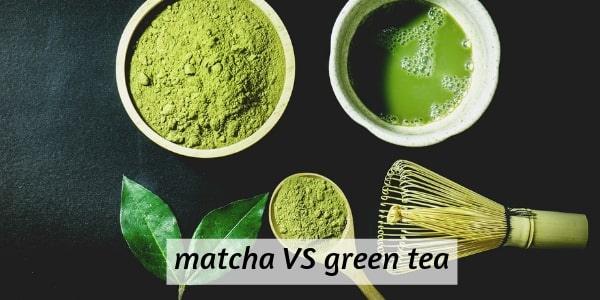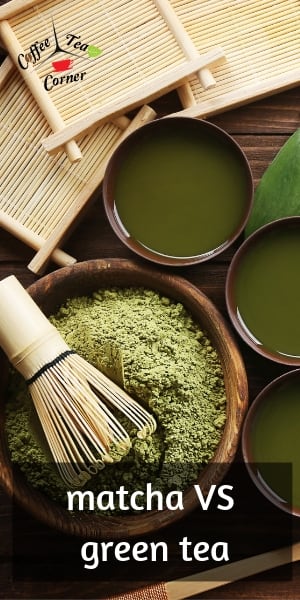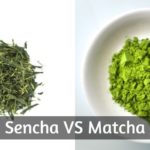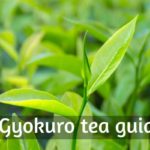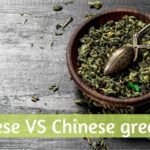Matcha and green tea are sometimes confused, and for good reason. They're both green, and almost the same tea. Yet they offer very different experiences when drinking the brew.
So what's the difference between a cup of Matcha and a cup of green tea ? We've got lots to discus, so let me explain.
Table of Contents
Both Matcha and green tea come from the same plant
All teas, as they were originally intended, come from the same plant. That plant is named Camellia sinensis, and you will find green tea, black tea, white tea, oolong tea, Pu-erh tea are all made from the same tea plant.
This means that Matcha too is made form the same plant as the green tea in your cup. It's just that they have very different journeys.
Green tea was the tea made before Matcha, and it was enjoyed in several Asian countries. It was processed in a certain way, and was adored for its fresh, grassy taste.
Over time the processing methods of the tea leaves became more and more specialized, obtaining different flavors from the same plant. This is how the Matcha came to be, as a more elevated and pure form of green tea.
Both green tea and Matcha are available across the world now, but they are most common in Asia. The West prefers its black tea (named red in the East), but over the past few years we've started to look into green tea.
Mostly for the health benefits, since this was the main thing that people talked about when describing green tea. Then the West noticed Matcha and its crisp, bright taste (and color) and wanted more of it.
So now we've got pretty much every flavor of green tea out there, available to enjoy. But let's see how green tea and Matcha differ from one another in terms of how they're processed.
What is green tea, and what is Matcha ?
Both green tea and Matcha come from the same plant, yes. But let's clear thing up a bit now. Exactly what is green tea, and exactly what is Matcha ?
Green tea is any green tea, also named Sencha
Green tea is any tea that is:
- the young leaf of the tea plant
- very lightly oxidized, be it through toasting, steaming, or pan-searing
- is not left to ferment and is not smoked (like an Oolong for example)
So green tea is a very broad term describing tea leaves that are processed in a very specific way, from specific leaves. If you were to process the leaves more, you'd end up with an Oolong tea (neither black nor green tea)
If you were to pick slightly older leaves, and oxidize them longer, you'd have a black tea. Pick very young leaves, or the spears of the young buds, and lightly oxidize them, and you've got white tea.
Most green teas are named Sencha, which is the Japanese name for regular, plain green tea. You might find this name on tea boxes in your local supermaket. Very few green teas aside from Gyokuro or Matcha actually produce a green brew.
Conversely, Gyokuro uses the exact same leaf as a Matcha, they are oxidized the same, and afterwards they're treated very differently. Gyokuro remains a full leaf green tea, often producing a greenish brew.
Matcha is a very specific type of green tea
Matcha is a green tea by itself as well, not a simple Sencha though. It is a Japanese tea, and isn't produced anywhere else or by any other method than the Japanese method.
That means that the tea leaves are steamed, rather than pan-seared or baked in the over in order to oxidize. This will keep the leaves' green color, and produce a bolder, greener flavor in the tea.
While Sencha is made of tea leaves that were grown both in shade and direct sunlight at a high elevation, Matcha is very specific. The leaves used for Matcha are grown only in the shade, and they keep a deeper, brighter green color.
This matters in the final product. The tea leaves are picked, they are lightly steamed (as the Japanese method requires) and then allowed to dry. If they're kept as-is and rolled before they dry, they become Gyokuro tea.
If they are de-veined and the stems are removed from the leaves after drying out, the leaves are then ground into a very fine powder. Removing the veins and the stems improves and balances the taste of the Matcha, and you're left with only the pure leaf.
The resulting powder oxidizes very quickly, and the brighter it looks, the fresher it is or the higher quality leaves were used.
A Matcha will always be bright green, unlike a green tea
When it comes to the color of these two teas, there is much to discuss. I'm talking about the color of the leaves and powder before infusion or brewing.
A green tea, whether Sencha or Gyokuro, will always be a dark green leaf. It will be dry, and at first you might say they're black, until you compare them side to side with black tea.
This color comes from the oxidation process the green tea is put through. When the leaves are picked they're bright green. Once they're baked or pan-seared or even sun-dried, they lose their bright hue, and start to darken their color.
Some might even develop a brownish tinge around the edges if processed poorly. In the case of Japanese teas, the leaves are steamed. This gives them a greener color, even after they dry out. Much like blanching vegetables when cooking, actually.
This oxidizing process affects the final color of the brew as well. Steamed teas will keep a greener hue. Baked or seared teas are dried at the same time they're oxidized, and this reflects as a yellowish hue.
A Matcha on the other hand is always going to be bright green, because the leaves are not only steamed but also ground into a fine powder. This makes them look like they're a lighter shade, since the powder is dried out as well.
In a way, Matcha should look almost fake, so green it should be. Wasabi is the closest thing in terms of color. The darker or more muted the color is, the older or poorer quality the Matcha is.
Their texture and taste are different
When it comes to brewing and tasting the green tea and Matcha, there are some very big differences as well. Let's start with how to properly brew green tea.
You will need 80 C/176 F water, and a measure of green tea leaves. Whether you use an infuser or tea bags, that's up to you. But your green tea should not be steeped for more than 2-3 minutes in the hot water.
A longer infusion time or too many leaves will produce a bitter green tea, which I'm sure you're not after. The second steeping will produce a more delicate brew, with the bitterness completely gone.
The resulting brew should be clear (the Japanese teas might be a little cloudy), and pleasant tasting. The taste of a green tea, a simple one, is usually grassy, slightly bitter, bordering on flowery.
It's definitely an acquired taste. It resembles seaweed and green grapes and cucumbers (except not as watery in taste).
As for Matcha, the preparation is very different. You will need a small bowl to drink the brew, since this drink is meant to be very vigorously mixed.
So in your small, shallow bowl you will need to add your measure of green powder and not very much water. The water, like with green tea, must be 80 C/176 F for the best results, otherwise your brew will be overly bitter.
Once you add a few drops of water, use your special bamboo whisk to make a sort of paste. The add the rest of the water to the bowl and whisk away until the drink becomes a frothy mixture.
Matcha is a suspension, and as such it will sink to the bottom of your cup if you won't whisk it again every now and then, or if you take too long to drink it.
This is one reason the drink is meant to be served in small cups or bowls. The texture of a Matcha will be thicker than a green tea, resembling hot cocoa rather.
As for the taste, it's much brighter and earthier, grassier than a regular green tea. If you don't really like green tea, you might not like Matcha at all.
And no, neither Matcha nor green tea go well with milk. No matter what your barista will say, this is a taste that is muted with milk.
(If you like this article so far, you can pin it to your Pinterest board by clicking the image below. The article continues after the image.)
Green tea offers less health benefits than Matcha
While both green tea and Matcha are essentially the same tea, they have a few key differences. They mostly lie in how the plant was grown and then processed.
The shade growth and picking time of Matcha gives it a larger number of antioxidants than green tea. This means that if you're looking for a healthy drink, then Matcha is your best bet. Green tea is great too, just less when compared to Matcha.
This is because the way Matcha is made is different than green tea. With green tea you steep the whole leaves, and when you're done you throw them out. This results in an infusion, but a weaker one.
A cup of Matcha on the other hand is the leaves themselves, which get crushed up and you end up drinking them yourself. You'd have to drink about 10 cups of green tea to get the effects of a cup of Matcha.
Matcha is more of a premium tea
Seeing as Matcha is better than green tea in terms of nutrition, it comes with a higher price point. Not only because of nutrition, but also because of the role Matcha is meant to play in the traditional tea ceremony in Japan.
This is the tea that was used for tea ceremonies, and it was refined over the years. As such, it's a premium item and won't be easy to find for everyone.
There are two types of Matcha on the market: food-grade Matcha, and premium.
Food grade is cheaper than premium, is much stronger and slightly more bitter.
It's meant to be used in foods and drinks, and still keep its bold flavor even when mixed with cream or sugar. This is what you will find in your Matcha latte, and in many tea shops as well.
Premium Matcha is a higher quality powder, usually brighter in color, and it's the tea meant for special events. This kind of Matcha powder is going to give you a thicker suspension, and its taste is more palatable and delicate than food-grade Matcha powder.
So the price point you'll find your Matcha at is going to differ according to what grade of Matcha you're getting too.
An example of good, pure green tea and Matcha
I'm going to give you a couple of examples of a green tea and a food-grade Matcha so you can try them both. Just remember that green tea and Matcha will give you different experiences.
You can't expect Matcha to be as delicate as a green tea, since it's a much stronger brew. Also green tea does come in several blends, aside from just pure green tea.
Matcha on the other hand is just Matcha, meant to be enjoyed on its own with no added flavors.
Green tea, loose leaf
This loose leaf green tea is the green tea in its simplest form. It's a Japanese made green tea, grown on a family farm.
You'll be able to enjoy green tea as it was meant to be enjoyed back when green tea first came to be.
When dealing with loose leaf tea, make sure you have a good infuser. Or, steep your tea in a pot of water and then strain your tea into your cup.
Remember that green tea is a delicate one, and should not be made with water hotter than 80 C/176 F.
Once you've had a taste of this loose leaf green ta, you'll know the base taste of a green tea. Smooth, grassy, delicate, and you might feel a bit of tingling on the sides of your tongue, near the back end.
That's the tannins present in your green tea, and they give green tea most of its health benefits.
You can check the listing for this tea on Amazon, and read the reviews as well.
The tea that comes in this package will provide 20-30 servings, depending on how many leaves you use fro a cup. I'd sure your can double that amount by reusing the tea leaves with care.
Matcha
When it comes to finding a good Matcha powder and serving set, it's going to get a little tough. I looked around for some time and found this set that comes with the actual Matcha powder, as well as the traditional whisk, bowl, scoop, sifter, and rest for the whisk. All set out nicely on a tray.
It's a higher price point than the green tea, yes, but this is Matcha after all. There are several colors you can choose for the bowl, the one I've linked here is black.
When making your bowl of Matcha be sure to read the instructions on the set, so you can get the best possible Matcha.
As far as I can tell the Matcha powder in this set is a premium one, so it should have a smoother, more palatable taste.
Still stronger than a regular green tea though.
A word about Matcha whisks though. Seeing as they are always made out of bamboo (so, wood) their ends will uncurl after a few months. You need to care for them and clean them properly, and this tea set will help you with that.
If your whisk does get very damaged, it can be easily replaced so do not worry.
You can check the listing for this set on Amazon, and read the reviews as well.
Final thoughts
When looking at the differences between Matcha and green tea you'll notice there aren't that many. In the end they are both green tea, just that Matcha is a very specific and special kind of green tea.
You will find Matcha in specialty shops or online, but you'll find green tea easier and in more places. In the West Matcha is still considered more of a trendy drink than a healthy one, and I think it's rather a shame since Matcha really is that good for the body.
Still, I'm glad it's at least a trend and people are having the drink.
If you want to know more about coffee or tea, feel free to check the related articles below. Who knows what else you might find ?

